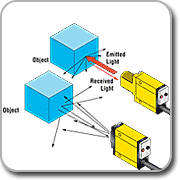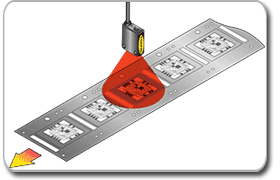|






| |
|
Divergent Mode Sensing |
|

How It Works
Divergent-mode
sensors unlike diffuse-mode sensors, produce a very wide light beam.
As in diffuse-mode sensing, light emitted from the sensor strikes
the surface of the object and is diffused back, sending a very small
amount of the sensing light back to the receiver, which is usually
housed with the emitter. Divergent mode sensing is different from
diffuse-mode sensing because divergent sensors do not use a lens to
collimate the light beam. So instead of a narrow beam, the divergent
mode sensors emit a wide beam of light. Think of it in terms of
camera lenses: divergent is like a wide-angle lens while diffuse is
like a telephoto lens.
|

Diffuse - Narrow Beam (Above)
Divergent -Wide Beam (Below) |
|
Pros: Clear Materials
Divergent mode sensors are reliable for sensing clear materials.
Because of the wide angle of the emitted and received light beam,
some portion of the object is always perpendicular to the beam. This
is particularly useful for detecting plastic films that bounce or
"flutter" (Bouncing
or vibrating movement of a sensing target).
However the sensing range is typically limited to a few centimetres
or less.
Pros: Small Objects
A divergent mode sensor can be used to sense very small objects at
close range because the divergent mode is not prone to "blind spots"
like diffuse-mode sensors. We supply sensors that can see a profile
as small as a thread passing within 2.5 centimetres of the sensor.
Pros: Shiny Surfaces
Divergent-mode sensors are tolerant of shiny surfaces that vibrate,
like metal foil webs. Divergent mode sensors can also reliably "see"
shiny radiused objects, such as cans, as long as there is a
significant gap between the objects.
Divergent mode sensors run out of excess gain very rapidly with
increasing range. They can be used successfully in areas where there
is a background object that lies just beyond the sensorís range.
|
Cons: Side Sensitivity
The field of view of a divergent mode
sensor is extremely wide. Objects that are off to any side of the
sensor (e.g. conveyor guide rails) may be sensed.
For this reason divergent mode sensors should not be recessed into a
mounting hole.
Cons: Low Excess Gain
The divergent sensing mode is very
inefficient. Most divergent sensors offer only low levels of excess
gain (The measurement of
the amount of light falling on the receiver of a sensing system over
and above the minimum amount of light required to just operate the
sensorís amplifierat
sensing distances beyond a few centimeters.
These sensors should only be used in clean to slightly dirty
environments.
|
Application -
Lead Frame Detection
Objective:
To detect the presence of an integrated circuit lead frame.
The wide beam of the divergent optics senses the lead frame, even in
areas where most of the metal is removed.
|
 |
Review
Like diffuse-mode sensors, divergent-mode sensors
detect an object when that object bounces light back from the
sensor's emitter to the receiver. However in the divergent mode, the
sensor casts a much wider angle of light.
Divergent-mode sensors are excellent in applications which involve
detection of clear materials, small objects, shiny surfaces, and
where background rejection is necessary.
By design,
divergent-mode sensors make inefficient use of sensing light energy,
and offer only low levels of excess gain. Also, they have a very
wide field of view, and caution should be used in applications where
an object on the side of the sensor may be detected.
NEXT |
|